

Reduce the use of plastic - THE SEVENTH CONTINENT. OR&R's Marine Debris Program. On the ground, there is the seventh continent for a long time. On the ground, there is the seventh continent for a long time to save the planet What is the seventh continent of the Earth?
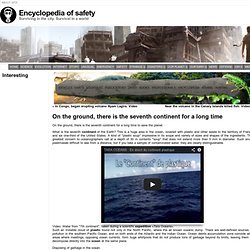
This is a huge area in the ocean, covered with plastic and other waste to the territory of France and six one-third of the United States. A kind of "plastic soup" impressive in its scope and variety of sizes and shapes of the ingredients. The greatest concern to oceanographers call at a depth of 30 m contents "soup" that does not extend more than 5 mm in diameter.
Such small plastmasski difficult to see from a distance, but if you take a sample of contaminated water, they are clearly distinguishable. Video: Water from "7th continent", taken during a scientific expedition «Tara Oceans». Plastic Garbage Project - Plastic garbage gyre. Enezgreen - Science News - A new expedition out to meet the seventh continent.
Storming a huge vortex of waste "The international community doesn't seem to care for now of this invisible ecological disaster.
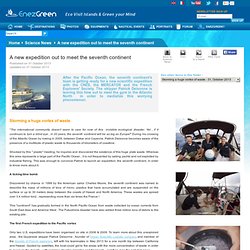
Yet , if it continues to turn a blind eye , in 20 years, the seventh continent will be as big as Europe! " During his crossing of the Atlantic Ocean by rowing in 2009, between Dakar and Cayenne, Patrick Deixonne becomes aware of the presence of a multitude of plastic waste to thousands of kilometers of coastline. Shocked by this " plastic" meeting, he inquires and discovered the existence of this huge plate waste. Whereas this area represents a large part of the Pacific Ocean , it is not frequented by sailing yachts and not exploited by industrial fishing. A ticking time bomb. The 7th Continent: Kinetic Islands Clean The Great Pacific Garbage Patch- eVolo. Honorable Mention 2013 Skyscraper Competition Park Sung-Hee, Na Hye Yeon South Korea.

Are There Really 'Continents' of Floating Garbage? Since stories have started surfacing more recently, many have wondered, if the rumors are true.
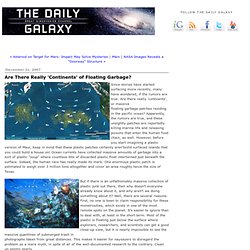
Are there really 'continents', or massivefloating garbage patches residing in the pacific ocean? Apparently, the rumors are true, and these unsightly patches are reportedlykilling marine life and releasing poisons that enter the human food chain, as well. However, before you start imagining a plastic version of Maui, keep in mind that these plastic patches certainly aren'tsolid surfaced islands that you could build a house on! Ocean currents have collected massive amounts of garbage into a sort of plastic "soup" where countless bits of discarded plastic float intertwined just beneath the surface.
Indeed, the human race has really made its mark. But if there is an unfathomably massive collection of plastic junk out there, then why doesn't everyone already know about it, and why aren't we doing something about it? Kiernan says it’s killing wildlife in a vicious cycle. Posted by Rebecca Sato. The 8th continent: Pacific Ocean garbage patch. The Great Pacific Ocean Garbage Patch is one of the biggest environmental problems that no one knows about.

Right now there is an area larger than the size of the continental United States in the Pacific Ocean between California and Japan that has more plastic in it, by volume, than plankton and other sea life. The swirling ocean currents conspire to aggregate trash that doesn't biodegrade (i.e. plastic) into a giant soupy mass of environmental pain. It's hard to know what to do about it. Plastic doesn't biodegrade and ends up just breaking down into smaller and smaller pieces. This plastic dust now greatly outnumbers plankton found in the area and causes massive damage to sea life when they eat it. And unlike a lot of environmental problems, we can't really pin this on any one group, corporation, political party or country. So what CAN you do? Some days it's hard to be an environmentalist. Www.Mappi.net : Maps of continents : The 7th Continent. The Seventh Continent — Musings on The Plastic Garbage Project.
Looking at the infographics on display at the Gestaltung Museum Zurich's Plastic Garbage Project exhibition, we could come to the conclusion that we are seeing the birth of a new continent, the plastic continent.
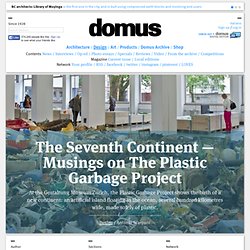
At least, I presume this would be the conclusion reached by a geologist in 3012 AD. The seventh continent is a float, bobbing around and practising an accelerated form of plate tectonics. An artificial island, several hundred kilometres wide, dozens of metres thick and principally made up of different types of plastic, is forming right in the middle of the ocean. Garbage ends up in the sea, one way or another, and is amassed by the oceanic currents.
At the end of its use cycle, this plastic starts to be a continent, no longer containing what we produce but instead containing us. Top and above: Out to Sea? No, there is something else behind this vague sense of guilt. A dying species cought in a fish net, USA, 2007. Floating plastic bags, Greece, 2008. A Seventh Continent Called Pacific Trash Vortex. Discovering the seventh continent / News / actualites-agenda / Homepage - Mercator Ocean. Category : Education Posted the 2012/05/15.
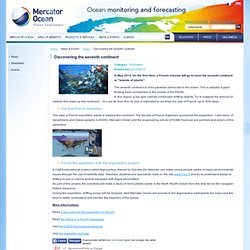
The Seventh Continent: 3.43 million km2 of waste floating off the Pacific. The “the seventh continent of plastic” There is an the seventh continent that is a third of the size of the United States but completely uninhabited.
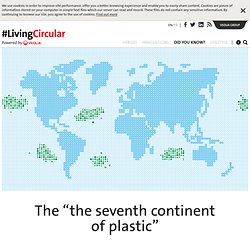
And for good reason, since it consists of an accumulation of plastic waste in the oceans. In 1997, the American oceanographer Charles Moore discovered the first vortex of waste in the sea: an area of 3.4 million square kilometers contaminated by floating plastic waste, accumulating in the North Pacific gyre, a giant swirling mass of water formed by the ocean currents.
Broken down into small pieces and micro-particles, the waste forms a “plastic soup” that is invisible to the naked eye. 300 million metric tons of plastic are produced each year and almost 10% end up in the ocean. (source: lemonde.fr)